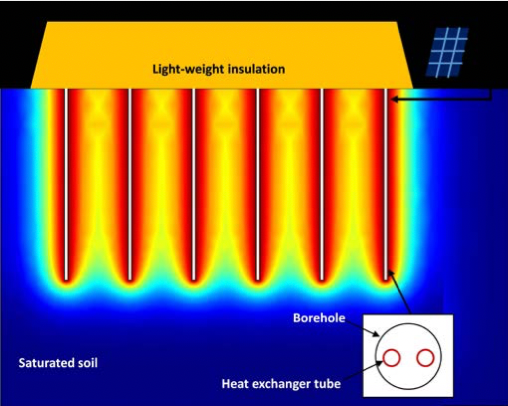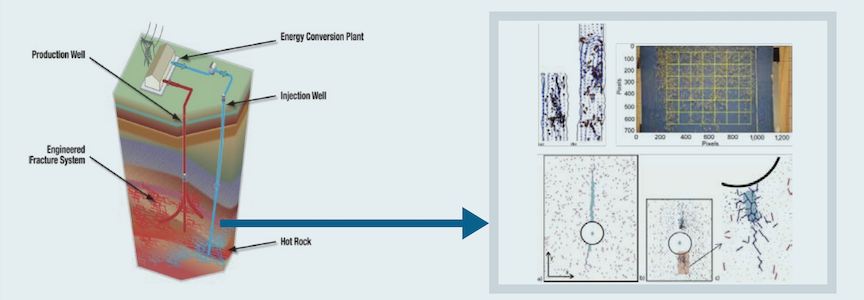Geotechnical Engineering and Geomechanics Projects
Principal Investigator(s):
John McCartney
Researcher(s):
Jeffrey Newgard
Summary:
The USA has a tremendous untapped renewable energy resource in the form of offshore wind and wave energy, industries that are now well-developed in other parts of the world. According to the Department of Energy, more than 2,000 GW of capacity, or 7,200 TWh of generation per year (nearly double our country’s current electricity use) could be harvested via offshore wind alone. Yet the cost remains prohibitively high and a large portion of installation cost is embedded in the foundation or anchoring elements for these offshore energy structures. Helical anchors (shown at bottom left) can be installed relatively easily by screwing a load-bearing plate into the seafloor, after which it serves as an anchor for floating wind turbines or wave energy generators (shown at top left, courtesy of Nemos). Our research centers around performing long term-cyclic loading tests on model helical anchors to develop more rigorous design guidelines and ensure their reliable serviceability over many years in the chaotic ocean environment.


Principal Investigator(s):
John McCartney
Researcher(s):
Fatemah Behbehani
Summary:
Energy piles are deep foundations that are used for supporting buildings and providing a clean renewable energy by exchanging heat between the ground and an overlying building. Energy piles are often installed in unsaturated soil deposits. Soil saturation conditions, properties and energy piles dimensions and spacing can influence the efficiency of the energy piles. The objective of this study is to simulate the long-term response and the efficiency of energy piles in unsaturated soils during heating and cooling cycles. The Model is implemented in COMSOL Multiphysics, a finite element analysis, solver and multiphysics simulation software. The model calculates the coupled behavior of the heat transfer and water flow considering nonequilibrium phase change and water vapor diffusion in unsaturated soil. Sensitivity analysis was used to highlight the effect of the soil saturation condition and parameters for a one pile case. Results show that the nonequilibrium phase change have a significant effect on soil temperature and the saturation levels.


Principal Investigator(s):
John McCartney
Researcher(s):
Wenyong Rong
Summary:
Unsaturated soils are widely encountered in engineered
geostructures like embankments or retaining walls involving compacted backfills, in near-surface natural soil layers above the water table, and even in natural soil deposits below the ground water table where occluded air bubbles are present due to ground water level fluctuations or decomposition of organic materials. In earthquake-prone areas, it is of great interest to understand the seismic compression mechanisms of unsaturated soil as well as its interaction with the transportation infrastructures. This research included innovative laboratory testing of unsaturated soils with controlled drainage conditions for pore water and pore air phases centered on the fundamental mechanics and physical model tests focused on the application of unsaturated soil mechanics to transportation infrastructure to lessen the impacts of earthquakes. The results in this study can provide sound experimental data for model development and constitutive model calibration for unsaturated soils, as well as to provide a design guideline which better addresses the geotechnical engineering problems consisting of unsaturated soils.



Principal Investigator(s):
John McCartney
Researcher(s):
Radhavi Samarakoon
Summary:
Cost-effective improvement of soft soil deposits encountered in civil infrastructure, offshore or river sediments, mine tailings dams and coal ash impoundments is a challenging geotechnical problem. This research assesses the feasibility of using solar thermal energy to improve the mechanical properties of soft soil deposits over different depth ranges. Specifically, heated fluid collected from solar thermal panels circulated through closed-loop geothermal heat exchangers in the subsurface is used to induce thermal volumetric contraction and a corresponding increase in shear strength of a targeted zone of soil. Advantages of this approach are that soil improvement can be gained in a targeted manner using renewable energy, after which the geothermal heat exchangers can be used for long-term underground thermal energy storage, yielding cost savings when compared to available soft soil improvement technologies. The results obtained from laboratory testing on kaolinite specimens subjected to a drained heating-cooling cycle show a clear increase in undrained shear strength. Further studies seek to better understand the fundamental processes governing the thermal volume change of soft soils over different depth ranges and to improve constitutive models for soft soils needed in advanced computer simulations.

Principal Investigator(s):
Ahmed Elgamal
Summary:
Three-dimensional (3D) nonlinear finite element simulations are becoming increasingly feasible for geotechnical applications. OpenSeesPL, created by J. Lu, A. Elgamal, and Z. Yang, is a versatile framework that uses a Windows- based graphical-user-interface (GUI) developed for 3D footing/pile-ground interaction analyses. Various ground modification scenarios may be addressed utilizing the 3D tool. Building on OpenSeesPL, a new GUI has been developed to combine nonlinear dynamic time history analysis of coupled soil-structure systems with an implementation of performance-based earthquake engineering (PBEE) for a single-column 2-span bridge configuration (research with Prof. K. Mackie, UCF). In this new interface, functionality is extended for analysis of multiple suites of ground motions and combination of results probabilistically using the Pacific Earthquake Engineering Research Center (PEER) PBEE framework. Definition of the bridge, the underlying ground strata, and the material properties are greatly facilitated via this integrated analysis and visualization platform
For more info, visit http://www.soilquake.net/openseespl and http://peer.berkeley.edu/bridgepbee
Principal Investigator(s):
Ingrid Tomac
Summary:
Energy geotechnics is an emergent field which relies on solving geomechanical problems for better extraction of renewable and sustainable energy from soils and rocks. Multi-scale and multi-physics problems are solved with aid of contemporary computational and experimental approaches, such as are Discrete Element Model coupled with computational fluid dynamics, micromechanical and laboratory scale experiments, Particle Image Velocimetry analysis of high speed camera images. Dr. Tomac team is putting experimental, theoretical and numerical effort to understand how dense-phase particulate fluid slurries flow in narrow, wavy, branched rock fractures. We will develop statistically supported theories for predicting placement of sand proppant in hydraulic fractures for efficient extraction of heat energy from deep enhanced geothermal systems (funded by NSF). Rock mass in 5 km deep geothermal reservoirs is subjected to coupled hydro-thermo-chemo-mechanical processes. Dr. Tomac and her team are developing novel failure and stress-strain theories for better predicting rock behavior during geothermal energy extraction.

